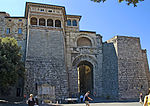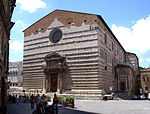Murder of Meredith Kercher
Meredith Susanna Cara Kercher (28 December 1985 – 1 November 2007) was a British student on exchange from the University of Leeds who was murdered at the age of 21 in Perugia, Italy. Kercher was found dead on the floor of her bedroom. By the time the bloodstained fingerprints at the scene were identified as belonging to Rudy Guede, an African migrant, police had charged Kercher's American roommate, Amanda Knox, and Knox's Italian boyfriend, Raffaele Sollecito. The subsequent prosecutions of Knox and Sollecito received international publicity, with forensic experts and jurists taking a critical view of the evidence supporting the initial guilty verdicts. Knox and Sollecito were released after almost four years following their acquittal at a second-level trial. Knox immediately returned to the United States. Guede was tried separately in a fast-track procedure, and in October 2008 was found guilty of the sexual assault and murder of Kercher. He subsequently exhausted the appeals process and began serving a 16-year sentence. On 4 December 2020, an Italian court ruled that Guede could complete his term doing community service. Guede was released from prison on November 24, 2021.The appeals verdicts of acquittal were declared null for "manifest illogicalities" by the Supreme Court of Cassation of Italy in 2013. The appeals trials had to be repeated; they took place in Florence, where the two were convicted again in 2014. The convictions of Knox and Sollecito were eventually annulled by the Supreme Court on 27 March 2015. The Supreme Court of Cassation invoked the provision of art. 530 § 2. of Italian Procedure Code ("reasonable doubt") and ordered that no further trial should be held, which resulted in their acquittal and the end of the case. The verdict pointed out that as scientific evidence was "central" to the case, there were "sensational investigative failures", "amnesia", and "culpable omissions" on the part of the investigating authorities.
Excerpt from the Wikipedia article Murder of Meredith Kercher (License: CC BY-SA 3.0, Authors).Murder of Meredith Kercher
Viale Sant'Antonio, Perugia Sant'Erminio
Geographical coordinates (GPS) Address Nearby Places Show on map
Geographical coordinates (GPS)
| Latitude | Longitude |
|---|---|
| N 43.1148 ° | E 12.3914 ° |
Address
Viale Sant'Antonio
Viale Sant'Antonio
06122 Perugia, Sant'Erminio
Umbria, Italy
Open on Google Maps










